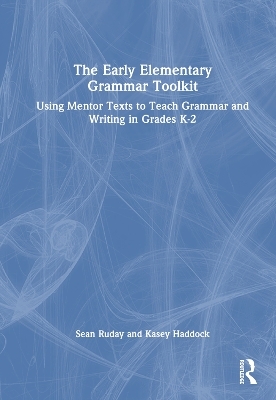
The Early Elementary Grammar Toolkit
Routledge (Verlag)
978-1-032-29818-4 (ISBN)
Teaching grammar can be overwhelming and is often an overlooked part of effective instruction, especially for young learners. The Early Elementary Grammar Toolkit to the rescue! This comprehensive guide makes grammar instruction in the K–2 classroom fun and meaningful.
You will learn how to:
Teach grammar in a practical and applicable way by presenting each grammar rule as a useful writing tool for students.
Use mentor texts—excerpts from great literature—to help students understand grammar in action.
Promote metacognition along the way so that students become responsible for their own learning.
Implement innovative instructional strategies and tools aligned with national and state standards.
Throughout the book, you’ll find step-by-step recommendations for teaching grammatical concepts to young learners, including the use of punctuation, capitalization, parts of speech, and more. With standards-based resources and activities for grades K–2, the book includes tips addressing teaching for each of these grades, classroom snapshots that show you the tools in action, flowcharts, infographics, and specific instructional recommendations to engage students.
Sean Ruday is an associate professor of English education at Longwood University and a former classroom teacher. He frequently writes and presents on innovative ways to improve students' literacy learning. You can follow him on Twitter at @SeanRuday and visit his website at www.seanruday.weebly.com. Kasey Haddock is a kindergarten teacher in Virginia. She has a true passion for shaping and molding the minds of future generations and laying the early foundations of students’ education. You can follow her on Twitter at @haddock_kasey.
Meet the Authors
Acknowledgments
Support Material
Introduction: Using Mentor Texts to Unlock the Tools of Grammar and Writing With Young Learners
1: Building Blocks: The Importance of Nouns to Effective Writing
2: Getting Active: The Impact of Verbs
3: Completing the Journey: Understanding and Constructing Complete Sentences
4: Finish Lines: How Writers Use End Punctuation
5: A Big Strategy: The Power of Capitalization
6: Question Time: Why and How Do Writers Use Question Words?
7: Time to Connect: Using Conjunctions to Create Effective Writing
8: More Than One: How Writers Indicate Plurals
9: Tools for Clear Communication: The Importance of Commas
10: We Are Writers: How and Why Writers Use Pronouns
11: Assessing, Learning, and Growing: Assessing Students’ Knowledge
Conclusion: Final Thoughts and Tips for Classroom Practice
References
Appendix A: Annotated Bibliography
Appendix B: Reproducible Charts and Forms You Can Use in Your Classroom
| Erscheinungsdatum | 10.02.2023 |
|---|---|
| Zusatzinfo | 27 Line drawings, black and white; 40 Halftones, black and white; 67 Illustrations, black and white |
| Verlagsort | London |
| Sprache | englisch |
| Maße | 178 x 254 mm |
| Gewicht | 520 g |
| Themenwelt | Schulbuch / Wörterbuch ► Unterrichtsvorbereitung |
| Sozialwissenschaften ► Pädagogik ► Schulpädagogik / Grundschule | |
| Sozialwissenschaften ► Pädagogik ► Schulpädagogik / Sekundarstufe I+II | |
| ISBN-10 | 1-032-29818-9 / 1032298189 |
| ISBN-13 | 978-1-032-29818-4 / 9781032298184 |
| Zustand | Neuware |
| Haben Sie eine Frage zum Produkt? |
aus dem Bereich


